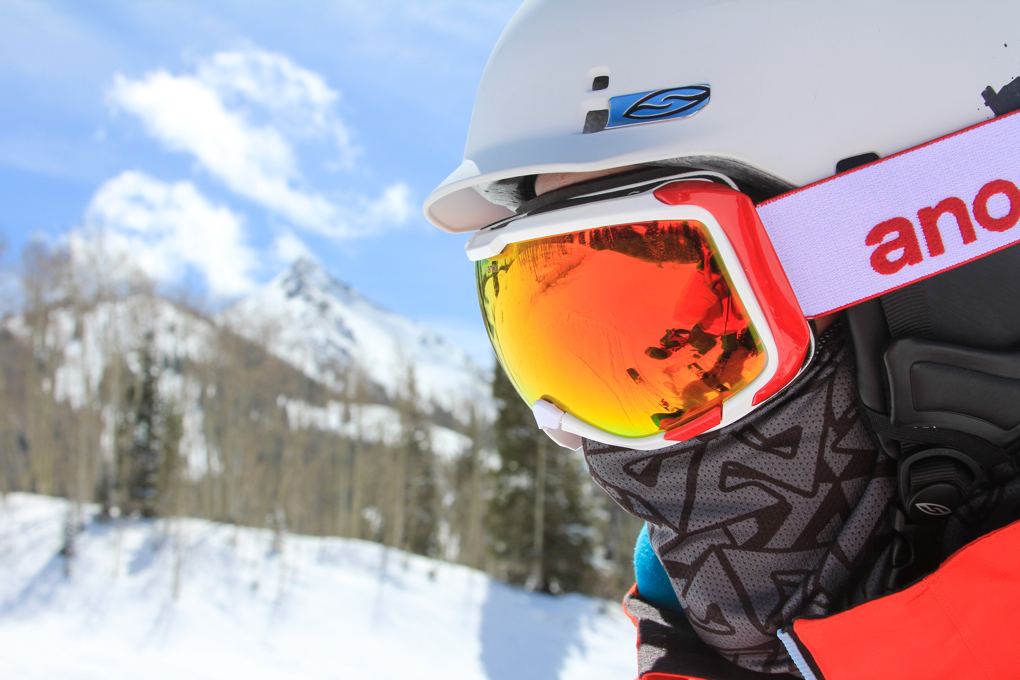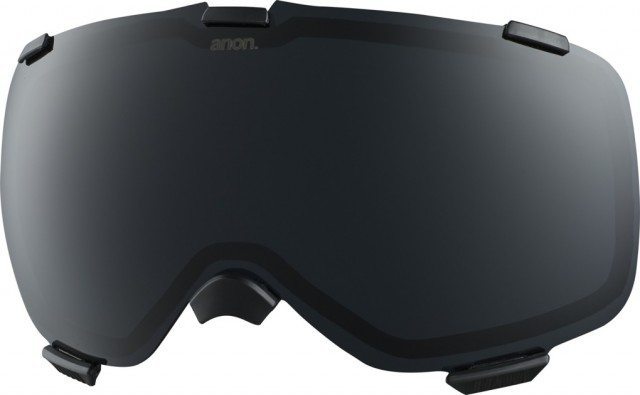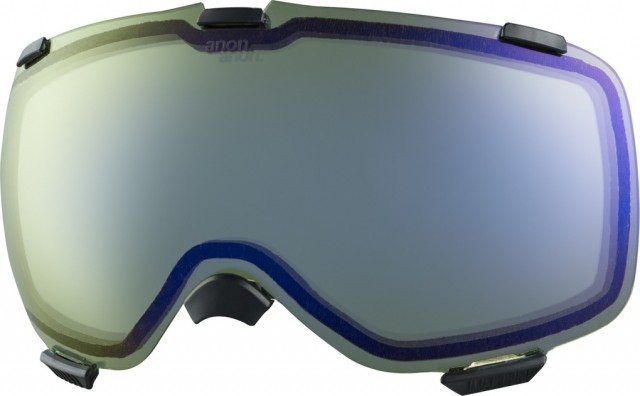Optics
I’ve worn the M1 in a wide variety of conditions, including sunny spring slush days; windy, whiteout storm days with seriously flat light; and on long bootpacks. Across the board, it has performed superbly.
Like the M2, the M1 comes with both a low-light and a bright-light lens as well as a compression molded case. The specific model of the M1 reviewed here —the “White” frame— comes with a Red Solex, bright-light lens and a Red Ice low light lens. We’ve also tested a few other lens tints from Anon that you might get (depending on the frame color you’re considering), so I’ll share some thoughts on those as well.
Red Solex:
Anon describes the Red Solex lens as having a “dark bronze base tint with a multi-layer Red mirror” that “maximizes color definition and increases depth perception in varying levels of medium light to bright conditions.” I would describe the Red Solex lens as having (or looking like it has) a yellow/amber color to it, which has performed flawlessly in sunny conditions. Even if you’re a dedicated fan of a true rose, grey, or blueish bright-light lens, I’d still recommend taking a look at this Red Solex lens—the glare reduction and contrast are top-notch. It sufficiently reduces the intensity of bright, sunny conditions, but doesn’t seem to have a grey, “cold” hue that markedly darkens one’s view. Anon’s Red Solex is definitely one of my favorite bright-light lenses.

Red Ice:
The Red Ice, low light lens is somewhat unusual. Anon describes it as a “clear base lens with a Red Mirror to flush out depth perception under night pipe lights”. Usually low light lenses have some tint to them to help with contrast in flat light, like Anon’s Blue Lagoon, which I’ll talk about below. But the Red Ice still does very well as a storm day lens, when visibility is at its worst, even though I would have thought its clear base would only really be useful while night skiing, as Anon mentions. While I think I still prefer a rose or yellow tinted lens, the Red Ice is a really nice alternative low light option especially if you do happen to do a fair amount of night skiing.

Dark Smoke:
As another bluebird lens option next to the Red Solex, I’ve been really happy with Anon’s Dark Smoke lens, which is pretty much identical to Smith’s Blackout lens. (You can read more about the array of lens options from Smith in our Smith Lens Guide.) Both are a dark grey tinted lens that do superbly in super bright conditions.

As a dedicated, sunny-day lens, I do think Anon’s Red Solex lens is a bit more versatile than the Dark Smoke, and might be preferable on a mountain that is heavily shadowed in the afternoon.
Blue Lagoon:
We’ve tested another low light option from Anon: the Blue Lagoon. Anon describes it as a “high-contrast Yellow base lens tint with a multi-layer Blue Mirror,” which “enhances color definition and increases depth perception in varying levels of low light conditions.”

At first, the lens looks very similar to Oakley’s H.I. Yellow lens, which Jason Hutchins speaks of highly in his review of the Airbrake. I agree with Jason, it is a great low-light lens. I used the H.I. Yellow lens in a pair of Oakley Crowbars as my low-light lens for a few seasons in the past. Similar to it, the Blue Lagoon has a nice, warm tint for those storm days when flat light can be a problem. However, as the ultimate low-light lens option, I think the Anon’s Blue Lagoon wins out over the H.I. Yellow.
In a back-to-back comparison, I found the Blue Lagoon to provide better, more faithful color transmission and even better contrast and detail in low and flat light. I say this not to devalue Oakley’s optics—again, it is a very good lens for storm riding—but primarily to illustrate just how good a job I think Anon has done.
All and all, I think the Blue Lagoon is my favorite low light lens to date—better than the Smith Sensor Mirror (which uses a light rose base tint instead of yellow), and better than Oakley’s H.I. Yellow.
Yellow/Grey Gradient:
I was initially pretty skeptical about this lens. Gradient tints aren’t something you typically find on any kind of performance eyewear, especially goggles. But Anon gave it a try, and I think they’ve done a great job making this design work as essentially a bright light lens. This lens has a “dark gray tint applied to the top of the lens [which] reduces glare from direct sunlight, while the yellow lower lens tint provides a brighter view of the terrain.” And it really does work well, just as Anon says. The gradient is fairly dramatic, and definitely noticeable when the sun is directly in your face. They darkest, grey portion at the top of the lens does a nice job of reducing glare from above, yet terrain in front of you is kept sharp through the contrast-boosting yellow tint. I don’t think I would prefer use this lens for seriously bright conditions (on a glacier, for example), due to the gradient tint, but I’ve really come to like it on partly cloudy days. So if you’re looking at a specific frame color of the M1 that comes with this tint, don’t be turned away because it’s a little unconventional.

All and all, Anon’s optics are on par with, and in some respects better than, any high-end product I have used from Smith or Oakley.
Pricing
There are two “versions” of the M1. Really the only difference between them is $20, some paint, and a piece of metal or fabric flare.
The MSRP for the M1 frame featured here is $199.95 and is one of the “Paint” models. You’ll notice that other “Premium” models of the M1 come in at $219.95. With a Premium model, all you’re paying $20 more for is an embossed emblem on the goggle strap or some kind of a patterned/printed, “specialized frame.”
Even with those slightly frustrating (basically pointless) price variations, Anon is right in the same price range with the M1 as its competitors in the interchangeable lens game. The lower priced “Paint” model M1s sit in between Smith’s 13/14 pricing for the I/O at $175 and Oakley’s asking price of $220 for the Airbrake (where the “Premium” M1 is tied).
Plus, it’s worth noting that while the M1 comes with a hardcase, a comparable case from Oakley or Smith will run you about $25.
Additional M1 lenses ring in at $89.95 for a mirrored spare lens and $79.95 for a non-mirrored lens. These prices are a little harder to swallow, since the majority of Smith’s spare lenses are $55 or less, with Oakley’s top-end mirrored lenses at $75 a piece.
Then again, with Anon’s Magna-Tech interface on each lens, this bump up in cost is a little more understandable (rare-earth magnets aren’t cheap). Given the quality of the optics in our pair, however, I doubt many people will really be looking for a third lens—I don’t think I would be.
If you do plan to buy a third lens for your M1s somewhere down the line, it’s important to know that that all extra lenses available to purchase for the M1 have black magnet tabs on them, not the color matched red and white ones that come with the pair we’ve tested here, or any other colored/printed frame. This means that unless your M1s have a black frame, you won’t be able to buy an additional third lens that will blend as well as the original two that came with the goggle (see the picture of the Yellow/Grey gradient lens above). This isn’t the case with the M2, as the lenses have no coloring to match the frame.
Bottom Line
In my book, the M1 is totally comparable to, and in some ways better than, the Smith I/O in terms of performance, and absolutely superior in terms of simplicity and ease when swapping lenses. If you’re looking for a quality, interchangeable lens goggle to give you the best options for optics in any conditions, you need to give the M1 a look. And if you like the look and fit of a larger frame, then absolutely check out the M2.

Those look great. I’m sure you’ve seen the new Scott interchangeable system. Was using a pair this weekend at Alta. It’s a tidy set up.
We sure have, Aaron. Nice to hear you’re a fan. We’re going to start logging time in Scott’s LCG soon, along with a production version of Anon’s M1 and the new M2 – there’s a lot out there to get stoked about in the interchangeable lens game these days. Stay tuned!
Will B
For some other info about the M1s they really were the easiest goggle I have ever used when swapping lenses. I even used them on a powder day and tomahawked twice that day and yard saled once and the lenses never detached so the magnets did their job. My only complaint about the M1 was that while riding fast and riding the lifts wind constantly came through the lenses around the frame. And on the next day when it was snowing snow flakes continued to flow through the areas of the lenses where wind was coming through as well disrupting my vision. My magnets were aligned correctly and it was not user error but turned out to be a manufacturing defect and thanks to Burtons rider warranty and my explanation of the problem Burton/Anon refunded my money on the M1s. After seeing the Changed made to the M2 I can’t wait to hear a review because I am interested in buying the M2s. Hope this comment helps
Hey Mike,
Thanks for weighing in. As far as I know, the design tweaks made to the M1 should totally eliminate any gaps or spaces between the lens and frame around the magnets. I can’t say I ever had problems like that with the pair I tested, but I’ll be sure to check this with the 13/14 production pair we’ll test. And yes, we’re really excited to take a look at the M2 as well.
Cheers,
Will
Hi Will – I have a question and a tip for other M1 users. First my tip is be careful how you clean these lenses – i washed the lens under the tap after a days use and the water got between the two lenses through the foam. i havent been able to see if its stained the inside of the lens yet – but if there is a water mark im guessing its impossible to clean out. Now can I ask a question please – Is the womens range of M1’s a smaller frame size or just different designs?
Hey Martin,
That’s a real bummer. I would try either putting the lens in a bag of dry, raw rice for a day or two. There’s a chance the rice will pull some of the moisture out of the lens. The other, ideal option would be to put the lens in a plastic bag with a bag of silica gel (not that you’d have one handy, but they’re the little baggies of “DO NOT EAT THIS” beads that sometimes come packed with a new pair of sneakers or electronics).
All and all, though, a ride under the tap may have spelled the end for your lens. For future reference, just use the goggle case your M1s came with to clean the lens – of you need a little moisture to get some fingerprints off, then breathing on the lens, creating a little condensation, should suffice.
As for the new WM1, I don’t know for sure, but Anon is calling it a “women’s specific design”, so I believe the frame dimensions are slightly different than the (men’s) M1.
Will
Thanks for the great review. I have loved my M1 goggles over the last year but I thought I should post to let people know that the lens retention is not wonderful for all people. I had an incident where someone got tangled up with me getting off a chairlift and I took a very slight fall in which I landed on my side and the side of my face. The lens popped out and the center top magnet broke off as well. The breaking off of the magnet also caused the lens to crack in that location. I have had the lens pop out several times before as well. A friend of mine also has a pair and he had the same magnet break off on a fall (albeit a nasty one). I don’t know if my head is just not a good shape for the M1 and leads to the lenses popping out fairly easily but it is a bummer to have an awesome goggle that has not quite lived up to the reviews or the cost.
I’ve used a pair of these for about 30 ski days so far, and have a couple of impressions I’d like to share. These are my first foray into ‘hi end’ goggles / optics and replaceable lens technology. Previously skied for about 10 years with a $40 pair of Spy goggles with a yellow tinted lens.
1) Everything said about the ease of lens change is absolutely correct. They are multiple times easier than changing those on my son’s IO7’s. If you feel the need to be able to swap lenses, you have to give these a look.
2) Construction details seem very good.
3) Regarding the venting, to me, these seem to have to much! My eyes can tear with these on while going up the chairlift if the wind is coming from the right direction, never mind while skiing. I’ll probably try to tape over some of the side vents; just seems that shouldn’t be necessary with a $200 pair of goggles. The cheap Spy’s I skied with previously did not exhibit this behavior, nor were they bothered with fogging issues.
4) Lens / Optics. Mine came with the Red Solex / Blue Lagoon combo. I agree with the reviewer’s comments about the Red Solex. I find the clarity and glare reduction top notch on Bluebird days, and, it’s also not too bad when you dip into the shadows. A great lens. Now, as for the Blue Lagoon, I’ll have to disagree with the reviewer. I was very unimpressed with that one. While it did perform better in low light than the Red Solex (as you’d expect), I didn’t think it was all that much better than my 10 year old Spy ‘economy’ yellow lenses. Maybe not even as good. It didn’t really light things up, and, didn’t seem to improve the contrast and detail of the snow surface conditions all that much. And with the mirror coating, in low light, I could see reflections of my eyes, which took away from the clarity of the image. And perhaps I was expecting too much. As I said, first foray into the high end goggle realm.
My primary reason for looking at this level of goggle, with the replaceable lenses, was to have improved low light visibility. That doesn’t seem to be the case, at least not to the extent that I feel would make the goggles worth the price. What I’lll probably end up doing is returning these and get a less expensive variety with a good single lens of 50% VLT or thereabouts. That’ll likely be good enough.
Just noticed the first comment also mentioned the wind. Mine don’t seem to have any manufacturing defect that I can see; the lens seems to seal tightly to the frame. Just the vents let too much wind thru, I think.
Will – how would I tell if this pair predated the ‘design tweaks’ that you mention above?